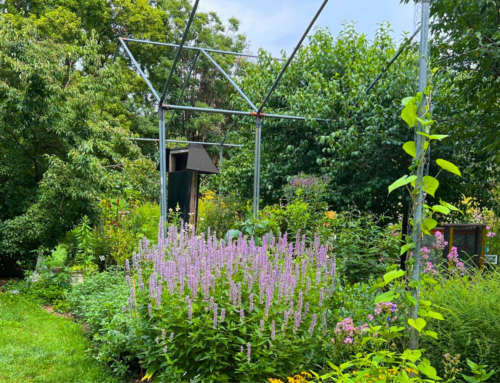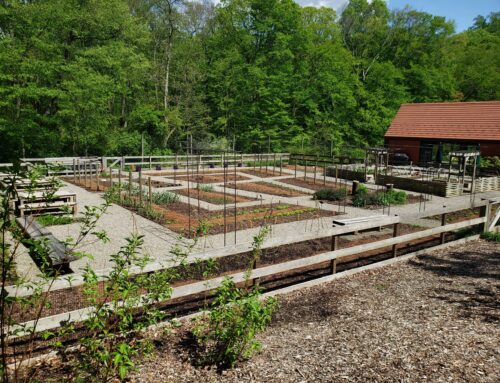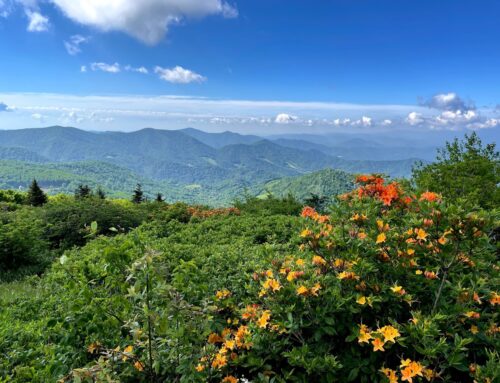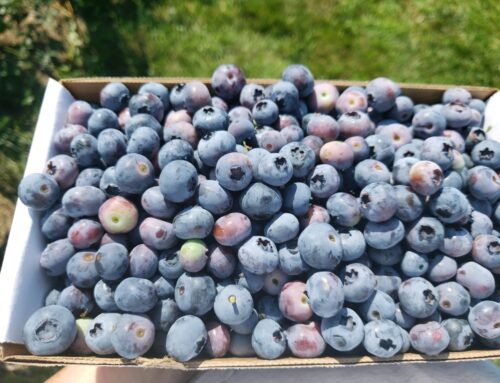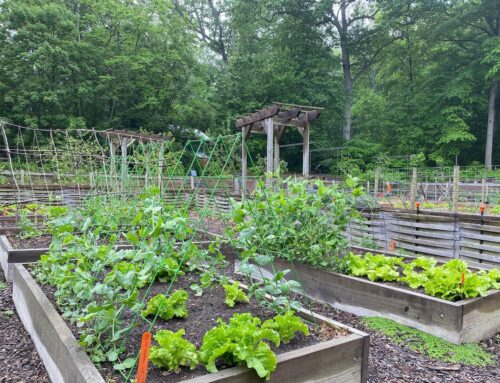It was finally early June. As we walked through the gardens in and around the Butterfly House, Steven and I tried to see it with new eyes. Were the plants healthy and growing as expected? With pruners in hand, we would deadhead spent flowers and snip a few main leaders on some younger plants to encourage branching and ultimately, more blossoms. We did have the help of rabbits with our outdoor pruning, although at times they didn’t know when to stop. The more difficult task of removing the flowers from newly planted plants promised future abundance, allowing the new plants to put energy into their roots. While we could use more plants in some areas, we were happy with the overall progress, especially outside the house. The plants inside would never receive the desired level of sunlight with the net in place. We tried to meet this annual challenge with our plant selections, tight planting and repeatedly trimming the small trees back.
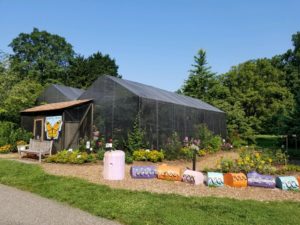
Late June is always a mental challenge as we expect more insect activity to accompany the warm days. Any time we were working people would stop to chat, telling us how beautiful it was this year. Every day we were asked the same question, “Where are the butterflies?” We answered questions about flowers and signage and chatted about plants, bees, and the overall improvements as we invited them to take a closer look, pointing out the attributes of plants selected to ensure a broad variety of pollinators would visit. This interest and excitement about what we were doing spurred us on. While we couldn’t tell them when the butterflies would arrive, we could talk about the native praying mantis nymphs that had emerged, show them the insects gathering nectar, and the native bee houses which were up. The foraging bees were mesmerizing, especially at the penstemon (Penstemon digitalis) where they could be found throughout the day. These outdoor tours were important and could start in April and go through November, extending the season of observation and learning by months.
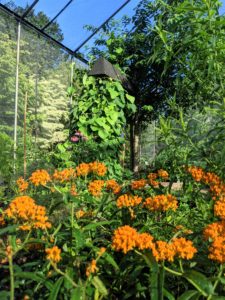 With July we found notable changes. More butterflies and bees, more flowers and additional species of insects. Then we found monarch eggs outside. We decided to officially open our doors to the Butterfly House on July 9, once we were able to have enough fluttering inside. We had a nice variety of butterflies including cabbage white, cloudless sulfur, spicebush swallowtail, fritillary and monarch. We had caterpillars including black swallowtail, monarch and cecropia. Seeing these creatures up close provides learning opportunities we wouldn’t have without the Butterfly House. The eggs are so tiny, and days later we have chunky caterpillars. How do they grow so quickly? How do the butterflies know which plant is the right one for their eggs? As we answered these questions, it reminded us that this is why we do what we do. People care and want to learn and help. The plants and insects are teaching us and we just have to watch and learn.
With July we found notable changes. More butterflies and bees, more flowers and additional species of insects. Then we found monarch eggs outside. We decided to officially open our doors to the Butterfly House on July 9, once we were able to have enough fluttering inside. We had a nice variety of butterflies including cabbage white, cloudless sulfur, spicebush swallowtail, fritillary and monarch. We had caterpillars including black swallowtail, monarch and cecropia. Seeing these creatures up close provides learning opportunities we wouldn’t have without the Butterfly House. The eggs are so tiny, and days later we have chunky caterpillars. How do they grow so quickly? How do the butterflies know which plant is the right one for their eggs? As we answered these questions, it reminded us that this is why we do what we do. People care and want to learn and help. The plants and insects are teaching us and we just have to watch and learn.
While the Butterfly House is a space created for the caterpillars and butterflies, the outdoor space is easily accessible and an invitation to all insects. A tour of the outside gardens results in unexpected discoveries. Look for ribbons tied to plants where you may find butterfly eggs or caterpillars. The hummingbirds can be shy, but they are there daily, sipping nectar from the bee balm and cardinal flowers. Clearwing Hummingbird moths love the phlox (Phlox paniculata), quickly sipping nectar as they methodically visit every flower. It’s difficult to see their wings, just like it is with a hummingbird. They are big, fast, and cause you to stop in your tracks.
The bees show us where the nectar is and it may surprise you. The coneflowers, zinnias and other flowers in the aster family may look like one flower, but there are many tiny flowers providing the insects with abundant nectar and pollen. The snapdragons seem tightly closed and only a large, strong bee can force the petals open far enough to get to the nectar. How many kinds of bees do you see? There are so many reminding us that there is much to learn. The bees are intent on foraging and don’t seem to notice us. Their legs and bodies may be covered in pollen. They might be tiny or large, shiny or dull, moving quickly or slowly.
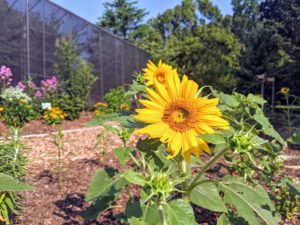
You may see the occasional predator looking for a meal. The native praying mantis sits silently as it awaits an unsuspecting insect to provide its sustenance. A single wasp travels up and down the milkweed leaves looking under each leaf for soft caterpillars to feed her young. Ladybug and green lacewing larvae feed on the aphids. The circle of life continues and the balance of nature is amazing. They all need to eat, and we can better understand why one butterfly will lay hundreds of eggs in just a few weeks. Many of these eggs and caterpillars are meant to be food more than they are meant to be future butterflies. The food chain is important as plants feed insects, who feed larger insects, birds, reptiles, and so on up the chain of consumers. No native insect is more important than another in this garden. We are learning from them and the plants.
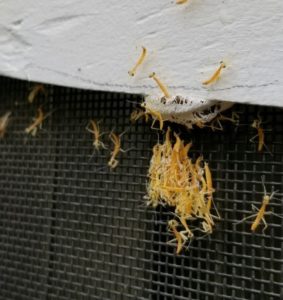
By mid-July, it was getting to be exciting. As I was leaving one day, a family with two young girls was coming in. I decided to stay, especially when the older girl said to me “I am seven and I know all about butterflies. I don’t think you should keep them trapped in here.” I loved her spunk and outgoing nature. I explained how our butterflies are safe and well-fed as we looked closely at some monarch butterflies and caterpillars. We talked about how a butterfly house can teach people how to help butterflies and other insects, which are so important to our world. She remained unconvinced as we arrived at the rearing cage. Three monarch chrysalides were securely attached to the top by the silk they had spun. With her eyes wide open she said, “I never saw these so up close! They are beautiful!” Then she understood, saying, “Oh, I see now. Seeing it up close is so cool! Mommy, can we grow some milkweed?” We still had lots to see and the chatter didn’t stop. Twenty minutes later they were on their way, promising to come back soon.
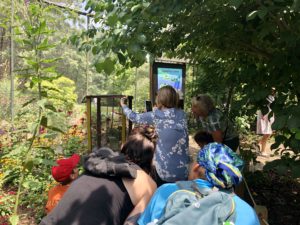
A few minutes immersed in the world of insects can be enough to change our behavior, and we see this happen multiple times every day. As visitors ask how they can have more butterflies at home, we talk about the native plants that will attract or sustain the butterflies and caterpillars. Some visitors are already actively enjoying pollinator gardens at home. We sometimes hear the sad story of a neighbor getting their lawn treated, and the pesticides drifting to our guest’s garden and killing all of their caterpillars. Because so many of our insects are declining in numbers, we have information on our bulletin board to educate our visitors on this topic. Whether you think twice about reaching for a can of bug spray or decide to choose some of your garden flowers based on their nectar value, we can all make a difference. It’s not only about the butterflies. They are beautiful, wondrous and even magical at times. They draw us in unlike a bee or other common insect can do. We find ourselves wanting to create a habitat in which butterflies can thrive, thereby allowing so many other insects and birds to also thrive. We all need to care for this world and in so doing, we are caring for native plants, insects, birds and so many creatures.
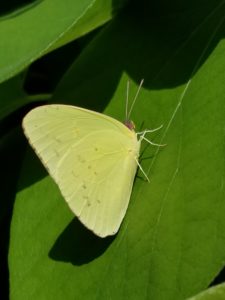
Even after the daylight hours begin to wane and the net is removed from the Butterfly House, the gardens will be actively supporting a variety of insects and birds as the autumnal nectar flowers attract them to the gardens. Hungry dragonflies and praying mantis will look for meals, while insects and birds prepare for the cooler weather. Additional birds will join the American Goldfinch, becoming more frequent visitors as the flower seeds mature. There will still be many butterflies, such as common buckeyes, monarchs and painted ladies, if that is what calls you to visit.
We started this dream twelve months ago, convinced we could offer more than seven weeks of only butterfly tours to our visitors. Along with so many volunteers, we built an environment that we hoped would be attractive to all insects. We built it, and they came! And you, our visitors and supporters have also joined us in this fascinating environment of plants and insects and we thank you for your conversations, support and visits!
“Life is full of beauty. Notice it. Notice the bumble bee, the small child, and the smiling faces. Smell the rain, and feel the wind. Live your life to the fullest potential, and fight for your dreams.”– Ashley Smith


